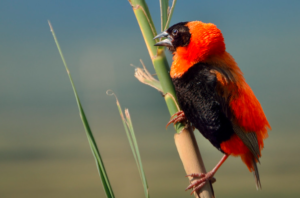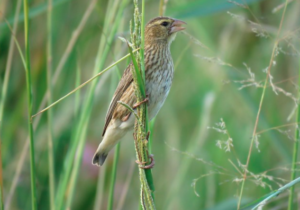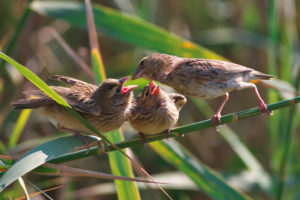Southern Red bishop | Uganda Birds
Southern Red bishop | Uganda Birds : also known as the red bishop is a small passerine bird belonging to the bishop. It is widowbird in the family Ploceidae and scientifically also known as “Euplectes orix”. Furthermore, it is a small dumpy sparrow-like weaver and is a common resident in wetlands and grasslands. Over the years, the native Red bishop was classified into two separate birds; Northern red bishop and southern red bishop. In fact, both species have similar appearances since they are sister species. However, they do have some distinct features to distinguish their differences. Both birds have almost the same color of plumage, including black, orange and sometimes red.
Physical description
 It is generally a thin, small dumpy sparrow like weaver with a length of 10-11 centimeters with a thick conical bill. The face, throat and forehead are black while the rest of the head is red. In addition, the upper parts are red apart from the brown wings and tail. The upper breast and under tail-coverts are red while the lower breast and belly are black. The female is very similar to the non-breeding male but she is smaller. Additionally, she is less densely streaked on the underparts and her bill, legs and feet are pale pinkish and her eyes are dark brown. Females and juveniles have thick, conical as well as horn-colored bills. On the other hand, males have a darker tinge to their bills and young males molt into their adult plumage at the early age of one year.
It is generally a thin, small dumpy sparrow like weaver with a length of 10-11 centimeters with a thick conical bill. The face, throat and forehead are black while the rest of the head is red. In addition, the upper parts are red apart from the brown wings and tail. The upper breast and under tail-coverts are red while the lower breast and belly are black. The female is very similar to the non-breeding male but she is smaller. Additionally, she is less densely streaked on the underparts and her bill, legs and feet are pale pinkish and her eyes are dark brown. Females and juveniles have thick, conical as well as horn-colored bills. On the other hand, males have a darker tinge to their bills and young males molt into their adult plumage at the early age of one year.
Behavior
Generally, this is a gregarious bird, often fond of the company of others, and usually go out in flocks whenever they build nests. As a matter of fact, they do it in groups thus creating nests in colonies not individually. These birds build their nests within reed beds near water to provide coverage from any nearby predators. The species feeds mainly on seeds from numerous plant species and arthropods and forages in small groups with the common starling birds. The species usually feeds twice a day; in the morning and in the late afternoon.
 Besides, the male bird is polygamous and may own up to seven or six females or even more in his territory. The southern red bishop also performs bumble-bee-like flight with rapid wing-beats producing buzzy sounds during the breeding period. It also flies airily about over the reed bed, with fluffed out plumage. Pairs and small flocks are always close to water when breeding and mixed species colonies occur in reed beds and swampy grasslands. However, they disperse into neighboring scrubs in the non-breeding season, often in flocks. The female species has various twittering calls and a nasal contact call while the male has a buzzing song.
Besides, the male bird is polygamous and may own up to seven or six females or even more in his territory. The southern red bishop also performs bumble-bee-like flight with rapid wing-beats producing buzzy sounds during the breeding period. It also flies airily about over the reed bed, with fluffed out plumage. Pairs and small flocks are always close to water when breeding and mixed species colonies occur in reed beds and swampy grasslands. However, they disperse into neighboring scrubs in the non-breeding season, often in flocks. The female species has various twittering calls and a nasal contact call while the male has a buzzing song.
Reproduction
This bird is a highly polygamous the reason as to why males build a number of nests in colonies.. The male successful mating is determined by the total number of nests built per male during the breeding season. In fact, the nests are characterized by the density of fibers in the nest chambers describing size and transformation. Females basically prefer nests that are more densely woven and have larger entrance roof covers and the nest durability. During the breeding season, the male birds build several nests averaging seven in the colony. This is done in order to attract females and to perform their display-flight to attract females. It is done using their puffed body plumage and this is why they are described as sexually dimorphic.
 The female basically lines the interior with plant grass and seed heads, and continues during the incubation. The nest is usually placed in reeds, maize fields, sedges and other aquatic plants standing in water. Besides, the males performs aerial displays over the territory to attract females in his colony during the breeding season. The female generally lays 3 pale blue-green or turquoise eggs and incubation lasts about 12-13 days done by the female only. After hatching, she also feeds the chicks, firstly by regurgitation of seeds. Later, they fledge at the age of 11-15 days after hatching, but they are always able to leave the nest at the age of 10 days. The young male can breed at two years whilst the young female can breed at one year of age.
The female basically lines the interior with plant grass and seed heads, and continues during the incubation. The nest is usually placed in reeds, maize fields, sedges and other aquatic plants standing in water. Besides, the males performs aerial displays over the territory to attract females in his colony during the breeding season. The female generally lays 3 pale blue-green or turquoise eggs and incubation lasts about 12-13 days done by the female only. After hatching, she also feeds the chicks, firstly by regurgitation of seeds. Later, they fledge at the age of 11-15 days after hatching, but they are always able to leave the nest at the age of 10 days. The young male can breed at two years whilst the young female can breed at one year of age.
Feeding and diet
Apparently on the feeding habit, this bird has a very simple food source, mainly including grass seeds. The bird also feeds on various grasses which are carotenoid producing pigments that give them the orange or red plumage. Besides the grass, they also eat small insects and they are considerably good at hunting insects. They can do this on land or whilst flying like beetles, caterpillars, termites, spiders, flies dragonflies, etc. The diet of the bird varies throughout the seasons, depending on what their body needs. In addition the bird also feeds on seeds of wheat, maize and about 24 other plant species.
Where to find them in Uganda
In Uganda, the Pearl of Africa you can find this marvelous bird in Bwindi Impenetrable National Park.






